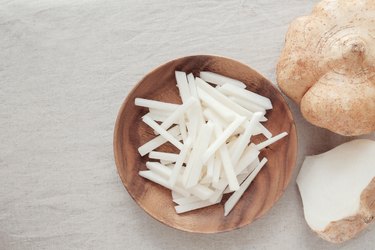
With its crisp, juicy texture and nutrient-rich content, jicama has many health benefits. But there are some potential side effects you should be aware of when it comes to the preparation of the tropical vegetable and which portion is safe to eat.
About the Jicama Vegetable
Video of the Day
The jicama vegetable, also known as singkamas or jambean, that you see in the markets is likely grown in Mexico, according to the University of California. The above-ground part of the plant is a vigorous spreading vine that can reach several feet in diameter and produce blue or white flowers and pods similar to lima beans.
Video of the Day
Underground, the globe-shaped, golden brown starchy root of the jicama is about the size of a turnip. It has a white-colored flesh that is most commonly eaten raw. Fresh jicama tastes very similar to apples — light, crisp and sweet, according to USDA.
Jicama can be diced, sliced or cut into strips for use in salads, with dips or as a garnish, often sprinkled with lime or lemon juice and a dash of chili powder. Jicama can also be boiled and absorbs the flavor of the foods it's cooked with.
Nutritional Content of Jicama
Jicama has fewer calories than white potatoes. One cup of raw jicama, sliced, contains only 46 calories, according to USDA. With no fat and no cholesterol, jicama can fit right into your weight loss program.
Most of the calories in jicama come from its carbohydrate content, with 10.6 grams in each cup of the raw vegetable. Your body need carbs for energy required to fuel your muscles, brain, heart and nervous system.
Although jicama is not a particularly good source of protein, providing only 0.9 grams per cup, the tuber provides a variety of minerals. According to USDA, some of the key nutrients in jicama are:
- 6 percent DV for copper
- 4 percent DV for iron and potassium
- 3 percent DV for magnesium and manganese
- 2 percent DV for phosphorus and zinc
A cup of sliced raw jicama also provides an abundance of vitamins, especially vitamin C. According to USDA, some of these include:
- 27 percent DV for vitamin C
- 4 percent DV for folate and vitamin E
- 3 percent DV for choline
In addition, jicama also contains many of the B vitamins, including thiamine, riboflavin, niacin, pantothenic acid and vitamin B6.
Side Effects From Fiber
Jicama has a high content of fiber, which can benefit the health of your digestive system by normalizing bowel function and preventing constipation. However, too much fiber in your diet can interfere with the absorption of minerals such as calcium, iron, zinc and magnesium, advises MedlinePlus.
Dietary Guidelines has established recommended daily amounts of fiber you need for optimal health. Depending on age and sex, the amount required for adult women is between 22.4 and 28, and for adult men it is 30.8 to 33.6 grams of fiber. A cup of fresh jicama contains 5.9 grams, or 24 percent of your daily value, on a 2,000 calorie per day diet.
Eating a serving of jicama along with other high-fiber foods may cause some digestive upsets. A large amount of fiber consumed in a short period of time can result in intestinal gas, abdominal cramps and bloating, according to MedlinePlus.
To help reduce gas or diarrhea, try adding fiber to your diet slowly. Gradually increase your intake over several days. Lightly steaming your jicama to soften the dietary fiber may make the fiber easier to digest. Once the natural bacteria in your digestive system gets used to the increase in fiber, these symptoms will be resolved.
Read More: 19 High-Fiber Foods — Some May Surprise You!
Toxic Effect of Jicama
Only the fleshy root portion of jicama plant is safe to eat. The seeds and stems of the plant contain a natural isoflavone compound, called rotenone. Rotenone has broad spectrum insecticide properties that protect the plant from predators, according to the report in a study from Toxins, published in March 2017.
Although it offers protection for the vegetable, rotenone is toxic to humans, fish and insects. Rotenone can cross the blood brain barrier and cell membranes and form free radicals, which can damage DNA, fatty acids and other components of the mitochondria.
The seed pods of the jicama can often be eaten when young, but the mature pods are toxic, according to Food and Agriculture Organization of the United Nations. Due to their high content of rotenone, at one time mature seeds of the jicama plant were commercially cultured as a source of insecticide. To be safe, eat only the tuber, and be sure to peel off the thick, fibrous outer skin.
- University of California Cooperative Extension: "Jicama"
- Republic of the Philippines Carlos Hilado Memorial State College: "Utilization of Jicama Chips Republic of the Philippines"
- USDA Wisconsin Department of Public Instruction: "Jicama"
- MyFoodData: "Nutrition Comparison of Boiled Potatoes and Yambean (Jicama) Raw"
- MyFoodData: "Nutrition Facts for Yambean (Jicama) Raw"
- MedlinePlus: "Fiber"
- Dietary Guidelines: "Daily Nutritional Goals for Age-Sex Groups Based on Dietary Reference Intakes and Dietary Guidelines Recommendations"
- Toxins: "The Molecular Basis of Toxins’ Interactions with Intracellular Signaling via Discrete Portals"
- Food and Agriculture Organization of the United Nations: "Traditional Crops"